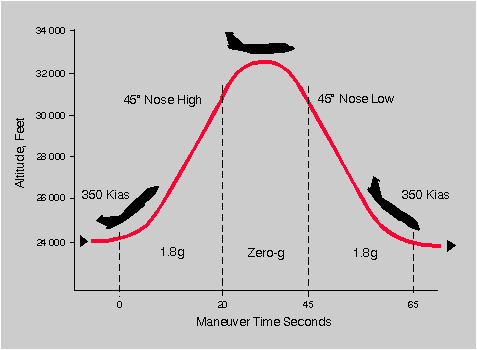|
Brave students to spin wafer coatings at zero G
‘Vomit Comet’: the ‘ultimate roller coaster ride’
|

O what a bumpy path they fly! — UNM students (and everything else) on the Sandia-backed NASA flight go weightless at the top of each arc — just enough time to perform a zero-gravity experiment and give their stomachs an experience to remember. The students will have 32 experiences of weightlessness in two hours, and will also experience twice Earth’s gravity as the plane pulls out of its dive to rise again. (NASA graphic)
Download 72dpi JPEG image, ‘comet.jpg’, 44K (Media are welcome to download/publish this image with related news stories.)
|
ALBUQUERQUE, N.M. — Braving almost certain stomach upset, Sandia National Laboratories student intern Jason Brown and three other chemical engineering students from the University of New Mexico will ride NASA’s wild-bronc-bucking KC-135A airplane — familiarly known as the “Vomit Comet” — on March 29-30.
The point is to learn whether, in the zero gravity achieved intermittently during the ride, a viscous coating can be deposited on a spinning silicon wafer more smoothly than it can be on Earth.
To find out, the students must ride a gutted, former stratospheric-tanker refueling plane as it climbs so sharply over the Gulf of Mexico that, photographed just above the clouds, it resembles a passenger plane lunging for the freedom of outer space. After accelerating upward at 2 G’s, the plane goes weightless near the pinnacle of its parabolic arc for about 30 seconds, when experiments must take place, and then accelerates downward at 2 G’s before rising again. In two hours, the four college students, riding in pairs, will experience 30 passes of weightlessness on each flight, along with one arc approximating the gravity of the Moon and another of Mars, on their two-G’s up, two-G’s down rides.
Is Brown worried about losing his cookies? Not exactly. “This,” he says, “is the ultimate roller coaster. And I love roller coasters.”
Brown and coinvestigating UNM student Kelly Kuhn readily agree that “Being All You Can Be” is not usually part of the reason people study chemical engineering. But they say their class is dedicated to changing the image of chemical engineers from “little guys with calculators and pocket protectors.”
“Of course, we expect to write a paper on this,” says Kuhn, who also admits she is debating whether to swallow a NASA-offered anti-nausea pill that will settle her stomach but might slow her thinking.
The KC-135A ride is popularly referred to as the “vomit comet” because about 60 percent of riders on these flights experience nausea. Similar intermittently weightless flights have been used by NASA in support of most of its major space initiatives.
What will happen to the coating at zero gravity is unknown and of scientific interest, agree Brown’s mentor Steve Thornberg and spin-coating guru Tony Farino, both employees of Sandia, a Department of Energy national defense lab. Thornberg provides technical guidance and helped obtain corporate support for the proposal that NASA accepted; Tony provided the students the necessary test equipment. The students — who also include Doug Peters and Bill Jackson, with Tom Gamble as backup — will vary the wafer’s spin speed, coating thickness, and rate of deposition. The results will be compared with identical tests run earlier in Earth’s gravity. The researchers may find that gravity makes no difference to the evenness of deposit. Or they may find that the absence of gravity means the coating won’t adhere at all but instead just floats off. Or they may. . . just may . . . help define parameters from which a better quality coating can be made.
There are other reasons for going. The UNM-based, Sandia-backed group won one of NASA’s 16 slots for student experiments — heavily competed for among hundreds of college student teams — partly because they intend to build on their already-demonstrated activism. “We plan to take videos and pictures of us floating, and after we come down, visit grade schools to show kids that science can be exciting,” says Jason.
But the golden fleece of Jason and the other argonauts is to form better coatings on their spinning silicon wafers. To achieve this, the self-named Spin Doctors have “ruggedized” their equipment by installing a metal frame around their plastic work bench. They secured the analytic equipment to the bench, installed bolt brackets to attach the table to the floor of the plane, completely covered the top of the spin-coater’s hood to prevent unwanted expulsions of material during weightlessness, and are considering changing plastic hood hinges to metal.
They will have eight days of training in Houston before going up with their project, and will bring their prized data — which in size, shape, and luster resemble CDs of the musical variety — back to Sandia for analysis.
Thornberg, who’ll be at NASA’s Ellington Field during the flight, hopes he doesn’t hear any radio message announcing, “Houston, we have a problem.” But he’s happy with the project. He says that the science of the trip is right in line with Sandia’s basic mission in semiconductors and the Laboratories’ long-standing support and encouragement of students, which is why Sandia corporately sponsored the UNM proposal to NASA.
Also helping are Sandia High School students Cindy Stallard and Jessica Saunders.
The title of the student experiment is “Study of Polymer Spin Coating for Photolithographic Semiconductor Development in Space.”
Sandia is a multiprogram laboratory operated by Sandia Corporation, a Lockheed Martin Company, for the United States Department of Energy under contract DE-AC04-94AL85000. With main facilities in Albuquerque, N.M., and Livermore, Calif., Sandia has major research and development responsibilities in national security, energy and environmental technologies, and economic competitiveness.
Media contact:
Neal Singer, nsinger@sandia.gov, (505) 845-7078
Technical contact:
Steve Thornberg, smthorn@sandia.gov (505) 844-8710
|
